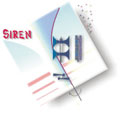|
|
1. Integrated solutions 2 Solutions that connect to any existing brand PABX The Ericsson DCT1800-S is a cordless system with analogue connections designed specifically for small and medium-sized businesses. It supports up to 8 base stations and 40 cordless phones, giving high quality cordless communication at an attractive price. It will maintain the value of precious investment in telecommunications because it adds on to the existing PBX rather than replacing it. The DCT1800-S is available in 4 pre-assembled versions
for 8, 16, 24 or 32 users. Therefore no internal installation work like
sliding in boards is needed. The system can be expanded up to 40 analogue
lines. The DCT1800-GAP system is targeted as stand-alone business cordless application, to be used together with a PBX. Except for cordless mobility, DECT does not offer a specific service; it is transparent to the services provided by the connected network. The DCT1800-GAP system can be connected to virtually any PBX or centrex lines. DCT1800-GAP is a cordless solution that integrates smoothly
with the existing PBX, so cordless voice communication and text messaging
can be added without having to replace the existing wireline infrastructure.
With capacity for 600 users via a digital interface and 216 users via
an analogue interface, the system is suitable for medium to large operations.
Thanks to the modular architecture and adherence to open standards, the
DCT1800-GAP can be easily expanded as the telecommunications needs evolve
well into the future. The radio exchange interfaces between the PBX and the base stations. Incoming and outgoing calls are routed via the radio exchange. The radio exchange is housed in a modular cabinet. The radio exchange is connected to the PBX by standard
analogue two-wire subscriber lines and/or by a digital interface.
Standards RS232 ports on the cabinet make it possible to connect a personal computer and a printer to the system. The personal computer is necessary for system initialisation, system fault tracing and system statistics information retrieval. A hardcopy of system error messages can be obtained via the printer. |
||||||||||||||||||||||||
|
||||||||||||||||||||||||||
|
||||||||||||||||||||||||||


